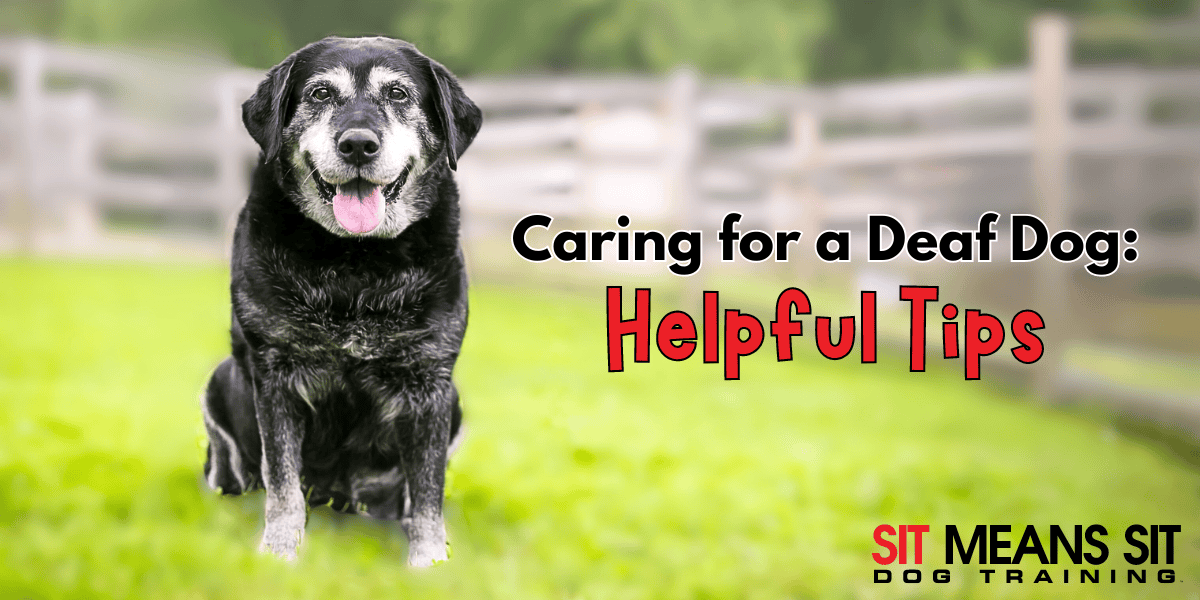Whether your pup was diagnosed with hearing loss recently, has been Deaf their whole life, or you’re caring for another person’s pup, the thought of taking proper care of a Deaf dog can be overwhelming. However, learning to properly interact with a pup with hearing loss can ensure you’re prepared to face any obstacles. Read the tips below to learn how to care for a Deaf dog while keeping them safe and happy.
Avoid Startling Them
Since a Deaf pup can’t hear you coming, it’s easy to accidentally startle them. Sneaking up on your furry friend can increase their anxiety and reactivity, so you should avoid this as much as possible. Luckily, there are several non-verbal ways to inform Fido that you’re approaching, such as by utilizing vibrations. This can be done by tapping the floor or taking slightly heavier steps near your pup before approaching them. If your furry friend is already awake and alert, get into their line of sight before you approach them.
Another option is to desensitize your Deaf pup from being approached from behind. After gently touching Fido on their back, reward them with treats and physical affection as soon as they turn around. Creating positive associations with being unexpectedly approached will prevent your pup from being frightened or reactive if visitors or other dogs approach them from behind.
Teach Hand Signals
Since your pup can’t hear verbal commands, it’s vital to teach them hand signals for key commands like “sit,” “stay,” and “come.” You can teach your pup hand signals to help them during playtime, such as assigning a visual cue to the command of “fetch.” Another important command that will keep your furry friend safe is an assigned hand signal for “watch me” or “pay attention,” which will help you get their attention from a distance. You can use American Sign Language (ASL), common gestures used for dog training, or create your own signals. Consistency is key, so start teaching your Deaf dog hand signals early and use them consistently.
Keep Them Safe Outdoors
A Deaf pup might miss danger cues, such as approaching cars or animals outdoors, meaning that they rely on you to be their ears. When taking your dog outside, keep your pooch on a leash unless they’re in a fenced-in yard to prevent them from getting hurt or lost. Supervise your furry friend at all times when they’re outdoors to ensure you know their whereabouts, especially if your pup is an escape artist.
If your Deaf dog manages to escape, it will be much easier to locate them if you’ve taken preventative measures. Keep your pup’s ID tags updated with your contact information, and consider investing in an additional dog tag to alert others that your dog is Deaf. We highly recommend microchipping your pup since this increases the chances of reuniting with a missing dog. Additionally, consider getting a GPS pet collar for your furry friend to see your pup’s location in real time. Most importantly, always keep your furry friend by your side to allow them to enjoy safe, supervised fun.
Keep Loved Ones and Visitors in the Know
As the owner of a Deaf dog, it is your responsibility to communicate your pup’s needs with others. Before allowing anyone to meet your pup, inform them that your furry friend is Deaf. From here, you can teach them how to safely approach your pup and use the proper hand signals. Having others interact with your pup using hand signals will reinforce your dog’s training and help Fido form closer bonds with your loved ones.
Visitors to your home may need reminders to use hand signals with your dog and avoid startling them from behind. If you frequently have new guests, you may want to put a sign near your front door that informs visitors that you have a Deaf dog. Make sure to alert groomers, vets, and any other individuals your pup will interact with about their hearing loss. Keeping others informed of your dog’s needs and training will help keep your pup safe and happy.
Have Compassion
Most importantly, use compassion when caring for a Deaf dog. Deaf pups may have more anxiety than a hearing dog, especially if their hearing loss is recent. You can comfort Deaf pups by creating a safe space in the home for them to go when they’re overwhelmed and need some peace. Additionally, ensure you shower your furry friend with physical affection to compensate for the lack of verbal praise. Use gentle pats to tell your pup what a good dog they are, or reward your pup for good behavior with yummy treats. Physical affection goes a long way when it comes to reassuring and calming your Deaf pup. Overall, take note of your pup’s emotions and anxiety levels and take action to help them feel at ease.
Owning a Deaf dog can present challenges, but it is undeniably rewarding. Despite their unique mode of communication, deaf dogs are just as capable as their hearing counterparts. With the proper knowledge and patience, you can guarantee that your furry friend lives a fulfilling and lengthy life.
Check out these related blogs for more dog tips!
Great Products for Your Senior Dog

